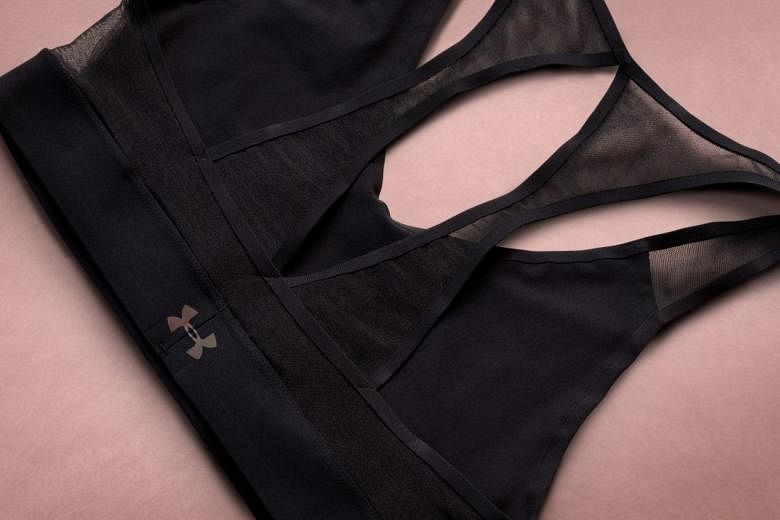WASHINGTON •The black sports bra and matching leggings that Under Armour began selling on Monday do not look particularly distinctive from the rest of the workout attire on its website.
But, in fact, the garments are different in a key way: They were made in the United States, marking a key milestone in the company's ambitious bid to significantly rethink its manufacturing strategy.
They are the first batch of clothing to be made at UA Lighthouse, a sprawling Under Armour facility that opened this summer in Baltimore.
A 35,000 sq ft design and product development hub, it is an anchor of Under Armour's attempt to figure out how to make clothing in the US - an unusual venture in an industry where manufacturing has largely been done overseas for a generation.
About 97 per cent of clothing sold in the US is imported, according to the American Apparel & Footwear Association.
Just 2,000 of the garments are available for sale - 1,000 each of the bras and leggings - so it is a small- scale start.
But the process of creating them offers a look at what the future of Under Armour - and the wider apparel industry, for that matter - might look like.
The company says that it was able to operate on a sharply shorter timeline for bringing the gear to market and it says it believes the Lighthouse set-up is cost-neutral compared with making clothing overseas.
With President Donald Trump talking frequently of finding ways to bring manufacturing jobs back to the US, Under Armour's experiment might end up drawing particularly close observation from retailers and Washington alike to see if it can be a blueprint for similar initiatives.
Mr Kevin Haley, Under Armour's president of innovation, said the process for creating garments such as the bra and leggings would typically take 18 to 20 months. For the Baltimore-made pieces, though, it took just three months.
He said that is because the Lighthouse set-up has enabled the company to compress the creation process in several ways.
Perhaps most important, when designers and manufacturers are in the same building instead of on different continents, they can combine their contributions to the supply chain into a single step.
"The designer is sitting in the Lighthouse facility with the person who's actually going to perform the operations to assemble that garment," Mr Haley said.
"So the person who's actually going to be putting it together is effectively going to be teaching the designer, 'Look, here's how to simplify this design and do it more efficiently.'"
He also said the technology in the Baltimore facility has enabled speedier garment production. By using 3D body scanners, Under Armour can figure out how a certain piece of clothing is going to fit and flatter a body without going the traditional route of producing a physical prototype.
The company also hopes this set-up will generally enable it to work in a more interactive way on clothing, allowing the team to fine-tune pieces after they have started to hit stores.
In the future, Under Armour might ship a small batch of clothes from Lighthouse and see how customers react to the gear before making tens of thousands of pieces of it.
If shoppers, for example, say a waistband is fitting a little snugly on a pair of shorts, they could tweak that for a bigger production run of that item. And being able to adapt to that feedback in real time could be powerful: It could be the difference between selling thousands of those shorts at full price, or having to mark them all down because shoppers were just lukewarm about them.
Reducing production time has become something of a holy grail in the retail world. Because of social media, live-streamed runway shows and other cultural changes, fashion trends go boom and bust faster than ever before.
One might be tempted to think these tectonic shifts mostly matter for fashion companies and not for performance athletic brands such as Under Armour. But, in fact, exercise attire has become a deeply trend-driven business.
Printed yoga pants, leggings with mesh panelling, workout tanks with strategically placed cutouts: These popular looks are all riffs on what is happening on the catwalk.
"It enables us to effectively pull forward materials, fabrics, textiles, yarns that the consumer maybe wasn't going to see until 2018, 2019 - and bring that into 2017," Mr Haley said.
But speed-to-market was not the only reason Under Armour pursued US manufacturing capabilities.
The company has a lofty goal of contributing to a revitalisation of Baltimore by creating jobs at Lighthouse and a planned roster of other facilities.
So what kind of labour force was needed to create these garments? After all, jobs going overseas is only part of the reason that the US manufacturing industry has contracted - many such positions have been lost to automation.
Under Armour said about 50 people worked on this particular garment collection, including design, manufacturing, marketing and other roles.
Mr Haley said the headcount of workers needed to create the products in Baltimore was "not all that different" from if they were made abroad.
He said: "It's not like these are being made by a robot.
"These are being made by human beings using advanced manufacturing methods."
Ultimately, Under Armour hopes that Lighthouse is a proof of concept for a bigger global initiative to embrace "local for local" manufacturing.
In other words, Under Armour gear sold in Brazil would be made in Brazil; gear sold in the US would be made in the US, and so on.
The goal, Mr Haley said, is to show that "if we can make it here, we can make it anywhere. And if we can make it here, anyone can make any product here".
WASHINGTON POST

